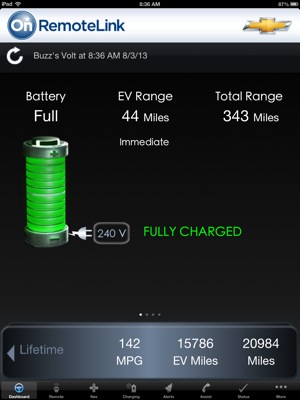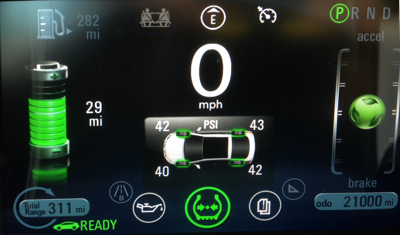 Well, my first year with The Flash, my Volt, is completed. As you know, if you’ve been reading my posts, I have loved every minute driving my blue beauty. But that’s not all the journey has been about, is it? The reason I’ve logged most of my drives in a spreadsheet was to find out if this car was a good economic decision.
Well, my first year with The Flash, my Volt, is completed. As you know, if you’ve been reading my posts, I have loved every minute driving my blue beauty. But that’s not all the journey has been about, is it? The reason I’ve logged most of my drives in a spreadsheet was to find out if this car was a good economic decision.
Unfortunately, being a newbie back in August 2012, when my lease started, I didn’t know that the kilowatt hours used (according to the center display) wasn’t the whole story. Not all the electricity sent to the Volt gets accounted for. Some is used just to heat or cool the battery, while it’s being charged. Sometimes, depending on the temperature outside, it may do this even when it’s not being charged.
A funny story about that: The charger shows how long the car has been charging. One night, my wife kept shoving me because she claims I sometimes snore (it’s a lie!). I moved to the couch around 1:00AM and slept there. When she went to the garage the next morning, the charger showed it was in the final minutes of a charge. She knew the charger had completed charging my Volt before we went to bed the night before, so she asked, “So. Where did you go in the middle of the night???”
One way to track every bit of electricity sent to the Volt is to use a Level 2 charger that compiles that data.
Fortunately, our Blink chargers do exactly that and even archive it on the Blink servers so we can look back more than the previous month’s data, which is stored on the charger. This backup is an important feature of our chargers, as both chargers went down for a short period and the technician had to reset their memory as part of the fix. Fortunately, I don’t believe any data was lost, since it was already backed up on the Blink servers.
Unfortunately, we had our Blink chargers installed on November 1st of 2012 and, consequently do not have accurate data on the amount of electricity used for the first two months I drove my Volt.
Here’s where the spreadsheet is helpful, to some degree. As mentioned above, I have a spreadsheet in my iPad that I use when I drive my Volt. I sometimes skip this if the drive is to the corner grocery store, so it is not complete, but one of the functions of the spreadsheet is to generate average miles-per-kilowatt-hour and miles-per-gallon. I wrote an article about the spreadsheet and made it available to my readers here.
One thing I wish I’d tracked from the beginning was if it was raining. I noticed the air coming from the vents would be cold even though I was running the fan only. In rainy weather, the Volt sometimes does this to defog windows or to keep the battery at an optimal temperature. I also wish I had tracked relative humidity, because that makes the A/C run too, probably for similar reasons.
Be that as it may, the spreadsheet has served its purpose and I will probably continue to use it throughout the three year lease for two reasons: 1) it is a good diagnostic tool to see if any problems are developing before they progress too far and 2) I’m a little anal-retentive and can’t help myself when it comes to tracking data.
So here’s what I’ve seen over the first years:
- Average miles-per-KwH: 4.17
- Average miles-per-gallon (when running on gasoline): 36.7
UPDATE (updated info in red): I have downloaded my charging history data from Blink and see that there is a considerable amount of electricity used conditioning the battery (i.e. keeping it warm in Winter or cool in Summer). This occurs while my Volt is attached to the charger. Also, there is some inefficiency in recharging a battery. In other words, not all the electricity used by my Blink charger gets used by driving. The Volt display shows only how much electricity is used to drive and does not have a way to measure these other electrical usages. I only have the Blink numbers for November through August, so I don’t have a full year of Blink data yet. I used only the electric mileage for the months I have Blink charger data and have extrapolated from that for the full year calculations. Due to this, I am updating the numbers above to this:
- Average miles-per-KwH: 3.31 (data from November 3, 2012 through August 3, 2013). The odd thing about this number is that it means I can travel 100 miles at the cost of 30.21 kWh. The government states that the Volt can go 100 miles on 35 kWh! I’m using only 86% of the energy predicted and I drive aggressively, in Sport Mode all the time! I’m also accounting for all the electricity sent from the charger, not just for driving.
- Average miles-per-gallon (when running on gasoline): 36.7 MPG. Oddly enough, the government’s prediction of 37 MPG when running on the range extender is right on the money.
Coupled with this image from the OnStar RemoteLink iPad app for the Volt, we can estimate my total cost of energy used to propel The Flash down the road. Using the same math I did, when I first started to see if the Volt was a good idea or not, I need to know what percentage of my driving used electricity and what percentage was gasoline-powered. That’s easy enough:
Using the same math I did, when I first started to see if the Volt was a good idea or not, I need to know what percentage of my driving used electricity and what percentage was gasoline-powered. That’s easy enough:
15,786 electric miles divided by 20,984 total miles shows I drive on electricity 75.23% of the time. The average Volt is driven on electricity about 65% of the time, so I’m moderately happy that I beat the average. However, I had hoped, by using a high speed charger, I could get that up to 90% electric and I was having success at that until a few things happened:
- I decided to attend the 2013 Chicago Auto Show in February. That was 2,000 miles that was mostly on gas. I thank G. Michael Murphy for his hospitality in putting me up (and putting up with me) at his home and for allowing me to use his Level 2 charger while there.
- I started a new job with Green Mountain Energy (my electricity provider for the last 12 years), selling 100% pollution free wind generated electricity. To do this, the salespeople travel to where potential customers will be, retail stores and special outdoor events (The July 4th Willie Nelson Picnic was especially fun and fragrant). I never know where I’ll be next, and I’ve travelled as far as 105 miles, round trip to do this.
- My 14 year old daughter, Zoe entered an engineering camp at The University of Texas. I became the designated driver to take her there and pick her up. The round trip for this was about 29 miles. The schedule prevented me from being able to grab a quick one hour charge, so much of this was on gas.
- We’re building a new, energy efficient home in Fort Worth, Texas and I drop by to check on construction progress every couple days (at least). That’s another 20 miles round trip.
No big deal, that’s why I bought the Volt, to live without range anxiety.
So, back to the math. If I drove 15,786 miles on electricity, I just divide by the average miles-per-kilowatt-hour (3.31) to get how many kilowatt hours I used, to arrive at 4,763.9 kilowatt hours, or 4.7639 megawatt hours (sounds more impressive that way, no?) My cost of a kilowatt hour has been stable at $0.107205 over the past 12 months, as I am under a contract. The cost of those electric miles was about $510.93.
Now for the gas miles. First, I have to say, like most Volt drivers, I HATE DRIVING ON GASOLINE! The beautiful silence we enjoy when driving electrically is gone, replaced with a low hum that becomes similar to a sewing machine on steroids, when we accelerate aggressively. Where was I? Oh yes, the cost of those gas miles. There were 5,198 miles driven on gas (20,984-15,786) and the average MPG was 36.7. So (5,198 divided by 36.7) that means I burned 141.63 gallons of premium gasoline. Over the last year, the price of regular gas, in my area, averaged around $3.42. Premium is usually 30 cents higher, so it averaged about $3.72. 141.63 gallons of premium gas at $3.72 per gallon would mean my gas miles cost approximately $526.88.
Notice one thing here: I drove three times farther on electricity and paid $15.75 LESS than I did for gasoline! My total fuel cost was $1,037.81 ($510.93 + $526.88). I’m pretty pleased with that. In my previous three cars (all Lexus ES300’s), I averaged 22 MPG, so the 20,984 miles I drove would have cost me $3,262.06 in my Lexus.
Did you see that? $3,262.06!!!!! 20,984 miles divided by 22 MPG equals 953.82 gallons of gas. My Lexuses used regular gas, not premium, so the cost per gallon was only $3.42.
953.82 gallons of regular gas times $3.42 equals $3,262.06. I SAVED $2224.25 IN FUEL COST BY DRIVING THE VOLT! (talk about burying the headline…sheesh!) In the world of cars, efficiency is usually calculated in miles per gallon (MPG). How do we equate a Volt to that, when it only uses gasoline occasionally? Well, we first have to look at miles per dollar (MPD). As I mentioned above, my Lexus fuel cost, for this previous 12 months would have been $3,262.06. My Volt’s fuel (gas & electricity) cost $1,037.81 for the previous 12 months. That means, per dollar, my Volt would go 3.14 times farther than my Lexus would ($3,262.06 divided by $1,037.81). If the Lexus averaged 22 MPG, then the Volt would get approximately 69 MPG (22 X 3.14)!
The U.S. Department of Energy rates the Volt at 94 MPG (on electricity). To arrive at this figure, they convert electricity to gasoline using the equation, one gallon of gasoline = 33.7 kWH of electricity. The result is that the DOE predicts you’ll spend $1,000 to go 15,000 miles. I went 20,984 miles and it cost me only $1,037.81. By the DOE’s calculations, I should have only been able to go 15,567 miles, on the money I spent on gas and electricity. Stated another way, the DOE predicted it would have cost me $1,398.93 to go the distance I did, instead of the $1,037.81 it actually cost me. Oddly enough, they rate the gasoline performance of the Volt at 37 MPG and I got 36.7. Since they rounded to no decimal places, those numbers are essentially the same. What this means is they nailed the gasoline efficiency but really missed it on electric efficiency, by about 33%. They predicted it would take 36 kWh to go 100 miles, whereas my experience is 30.2 kWh to go 100 miles, including inefficiencies in charging and battery conditioning. That is a discrepancy of 19%. Since, by dollar value, it looked like a 33% error but only a 19% error by miles per kWh, you can see how cost of gasoline, cost of electricity, charging efficiency, battery conditioning and driving style can affect the calculations. It’s a moving target. (by the way, I am a “Sports Mode” driver. I have a heavy foot)
My calculations are based on the cost of fuel, rather than the energy contained within the fuel. That’s a much more real world number to me. Also, the DOE does not consider electric charging inefficiency or battery conditioning as part of the cost. If you look at the numbers I had, before I added the Blink charging data, I showed the Volt getting 4.17 miles per kWh. If all that electricity could be put in the Volt with no loss and no battery conditioning, I would have been able to say the Volt was getting the equivalent of 77 MPG (trust me on the math).
On top of that, I didn’t have any oil changes for one year. If I had my oil changed every 5,000 miles, that would be 4 oil changes. (I can’t even remember what I usually paid for that)
But the icing on the cake, is knowing that, when driving on electricity, I was not polluting, not even at the power source, since it’s wind generated electricity. This is my “Blink Dashboard”: As I mentioned above, I have only had the Blink charger since November 1, 2012, so these stats only cover that time period. Just before the chargers were installed, I checked my electric mileage. It was 3,472. At the end of one year, it was 15,786. The graphic above covers only 12,314 electric miles. If we do a simple extrapolation of the data, my year of driving electrically actually did the following:
As I mentioned above, I have only had the Blink charger since November 1, 2012, so these stats only cover that time period. Just before the chargers were installed, I checked my electric mileage. It was 3,472. At the end of one year, it was 15,786. The graphic above covers only 12,314 electric miles. If we do a simple extrapolation of the data, my year of driving electrically actually did the following:
- Reduced carbon dioxide emissions 2,601 pounds, well over a ton!
- Saved 11.5 barrels of oil.
- Saved 495 gallons of gas, and (They’re conservative here. My calculations show, compared to my previous car I saved 717.55 gallons of gas.)
- Saved $1,180.68 (Again, they’re too conservative here. I show $2,224.25 overall. Just the electric miles saved me $1,494.17 compared to my Lexus. But what about comparing it to the Volt’s gasoline performance? If I NEVER ran my Volt on electricity, I would have used much more gas. How much more? 20,984 miles divided by 36.7 MPG equals 571.77 gallons of premium gas. The cost of that gas would have been 571.77 times $3.72 per gallon equals $2,126.99 in gasoline. The Lexus would have used $3,262.06 worth of gas, resulting in a savings of $1,135.07, when compared to the Volt’s relatively frugal gas mileage!
My lease payment is $330.07 per month. The savings in fuels, on a monthly basis was $185.35 ($2,224.25 divided by 12). If I saved $2,224.25 compared to my Lexus (which was paid for), the additional cost of owning and driving a Volt was only $144.72 per month! ($330.07 lease payment minus $185.35 monthly fuel savings) That doesn’t even include the savings of not having four oil changes!
Did you see that???? My effective monthly lease payment for the Volt is only $144.72!!!
I think I did the right thing.
One other thing. It’s a lease. This is the dashboard display, taken on the Volt’s first birthday. Notice the total mileage in the bottom-right corner. 21,000 miles!

Due to the reasons mentioned above, I’ve gone a bit over on my allotted miles per year. I can put 45,000 miles on my Volt over the three years I am leasing it. If I don’t get the miles down, I have to pay 25 cents per mile for the overage.
Let’s go ahead an say I’m going to average 21,000 miles per year (I won’t). The 6,000 mile overage will cost me an additional $1,500 per year. That comes to an additional $125 per month. If I add that back into my lease payment (after fuel savings) of $144.72, I end up with a lease payment of $269.72. That would not be nearly as exciting, and obviously, I expect my driving habits to drift back down to the 15,000 miles per year I have been driving for years now.
Again, let’s say I average 15,000 miles for the final two years of the lease, but fail to recoup the 6,000 mile overage from this year. The impact on the monthly payment would only be one-third of the previous estimate, since the $1,500 would be spread over the entire 36 months of the lease. In that case, I would have an effective lease payment of $186.39 ($144.72 plus $1,500 divided by 36 months). Still a pretty low monthly delta, compared to my previous, paid-off Lexus!
Discussion points:
- If you haven’t gotten an electric vehicle yet, what further questions do you have? What’s holding you back?
- If you have gotten one, What is it? and How do you like it so far?




nicely done…my first year will be closer to 10,000mi, but over 90% electric.
I am jealous of your 90%, but once we move into the new house, I plan to be right up there with you. Even MORE savings and positive environmental impact!
Nice! – Good to know there are other Two-Volt families.
Your numbers are quite confirming of our experience.
Love my Tesla S.
Don’t be mean!
2013 Leaf 100% electric. 6 months of ownership. 9000 miles, consumed 1900 kwh @ 10 cents per kwh. $190 in electricity to drive 9k. If I drove my 30 mpg escape hybrid that distance it would have cost me around $1100-$1200
Best part is I get reimbursed mileage for business travel. Even better when I return home with a greater charge than I left with due to free charging in parking garages.
I’ve owned a Volt for 1 month. Only driven it a little, in Januaary, in Vermont, I am deeply disappointed because my engine runs at least 95% of the time. It will run on battery for maybe 20 seconds, once or twice, on my 6 mile trip to or from town. Any suggestions? My gas per mile about the same as my Corolla but burning premium gas and cold (I don’t run the heat).
Bill, hang in there. Today, in Texas, it was 27 degrees out and my engine ran as well. One of the advantages of the Volt is it’s battery’s thermal management system. I haven’t been keeping tabs on Vermont’s temperatures last January, but I’ll wager it was cold. Keeping your battery warm with the engine will help the battery last for years to come. The gas engine also cures us of the dreaded “range anxiety.” In February of 2013, I drove from Texas to Chicago and back. I’ll be the first to admit I hate when the gas engine kicks in, but I’m also thankful it does. In cold weather, while still plugged into the charger, perform a remote start and let the battery warm up while using electricity from your home.